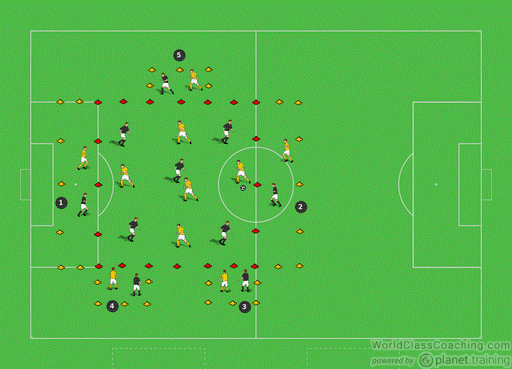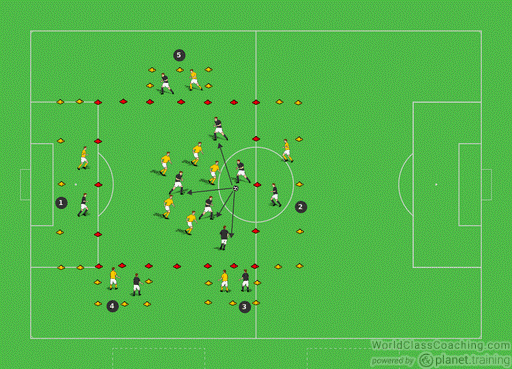By Anthony Hazelwood
The following activity is a long intensive and non-directional possession exercise aimed to train the speediness of play on a mental, physical, technical, and tactical level. On a tactical level, coaching emphasis should be on ball circulation and player movement. Although players are initially placed in a particular formation (2-1-2 or 1-3-1), this activity is intended to be more fluid and functional positioning is not as critical. However, as mentioned, the focus should be on creating spaces/support, ball circulation and speed of play within the attacking and attacking transition phases of the game.
On a fitness level, the soccer specific fitness target to work on is endurance, on a transient level, while adapting the player's aerobic power. Additionally, this activity features defined zones where players are waiting to participate and progressively come in at different moments. While healthy players should use a regular rotational pattern with teammates, these certain waiting periods may be used exclusively on players that are coming back from injury or are actively recovering from a previous match. It's important that coaches understand the basic standards of periodization on an individual, group, and team level to apply the correct loads of training.
When preparing the activity, if needed, concentration and difficulty levels may be increased by having players execute something extra unique by setting more restrictions. Every activity may be modified, and it is up to the coach to be creative. However, it is important to respect the parameters of the exercise time, the rest, the types of actions used and the weekly periodization of the activity.
Additionally, it is beneficial to train a soccer team and its players with all the elements of the game being present in the session. By doing so, it will promote soccer specific adaptations to the player’s body, mind and emotional triad. Ultimately, these adjustments will enhance their real-time game performances on a physical, emotional, conscious, and subconscious mental level.
Area Size: ¾ of the Field.
Total Activity Time: 30 Minutes.
Activity Repetitions: 4 repetitions.
Activity Work Interval Time: 6 minutes.
Recovery Interval Time: 2 minutes.
Intensity: High (Specifically for those in the central area).
Objectives:
- Tactical: Creation of space, support, ball circulation and proper attacking principles decision-making
- Fitness: Aerobic power training adaptations and fast/quick physical, mental-emotional, and neuromuscular – Central Nervous System (CNS), decision-making actions.
- Technique: Proper fitness and off/on the ball execution/techniques.
- Mental-Emotional: Players are fully engaged, and intention of actions are high paced.
- Concentration Level:
Setup:

- Field (red cones in the above diagram): 40 yds. Length X 44 yds. Width.
- Rectangular zoned areas located at the ends of the central grid (marked by yellow cones - #’s: 1 and 2 in the above diagram).
- Three 5 X 5 yds. Squares located on the sides of the grid (marked by yellow cones - #’s: 3,4,5 in the above diagram).
- In the central area, a 5 5 is initially played.
- In each outlined zoned area, there is one idle player for each team.
- The goal of each team is to bring all waiting players into the game.
- The objective of each team is to complete the number amount of passes reflecting the number of players their team has within the central area. For example, if the team starts with five players, they need to pass the ball five times.
- Once accomplished, a waiting player will enter the central area, creating numerical superiority.
- To activate more players, the total amount of passes must reflect the number of players each team has. For example, if a team has eight players in the central area, then the team of eight must make eight passes to enable the ninth player and so on.
Coaching Points:
- One of the most important aspects of possession activities is the creation of space and constant support of the teammate in possession of the ball.
- When supporting, it’s important that all supporting players are available as passing options.
- Minimally, there should be three players immediately supporting the ball. However, this point should typically be dictated by the number of defenders around the area.
- Rule of thumb: always try to be in numerical superiority.

- Ball Speed is another important aspect of this activity. The quicker the passes, the faster additional supporting players come into play.
- On a fitness level, keep coaching points during recovery breaks and only freeze the session if necessary, since doing so may disrupt the soccer specific conditioning aspect.
- To make this activity work at a fast rate, try demanding defenders to move and work together to minimize the attacker's space and time.
By Anthony Hazelwood
Current Seattle Sounders Academy Performance Coach with previous European academy coaching experience as an assistant fitness and strength/conditioning soccer coach with Levante U.D. (2013-2014) and Getafe SAD CF (2015-2016) in Valencia and Madrid, Spain respectively. A USSF “A” licensed coach with a BSc in Physical Education and an MSc in Sports Training and Nutrition.


